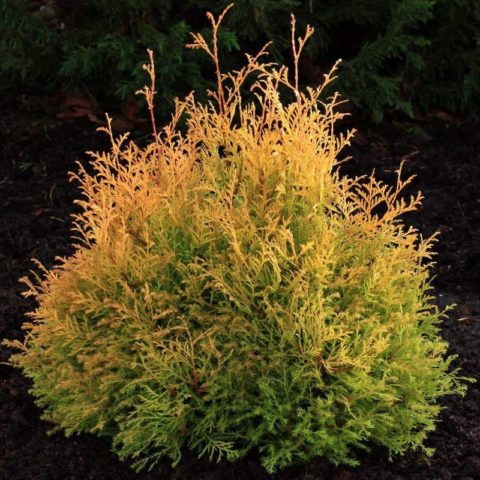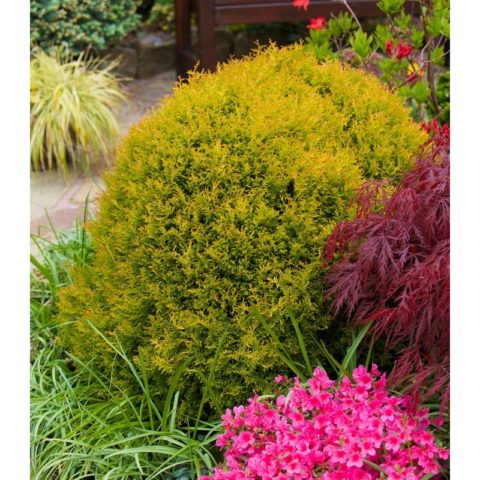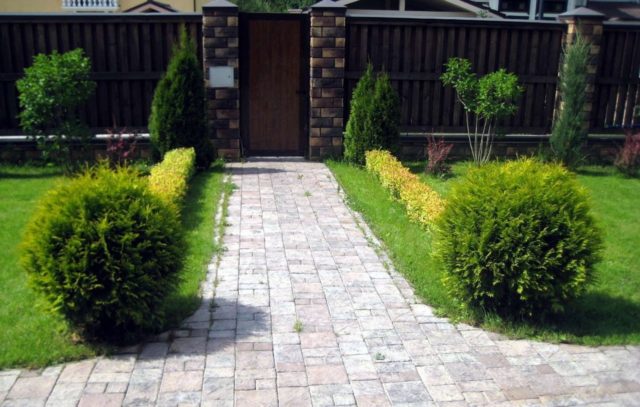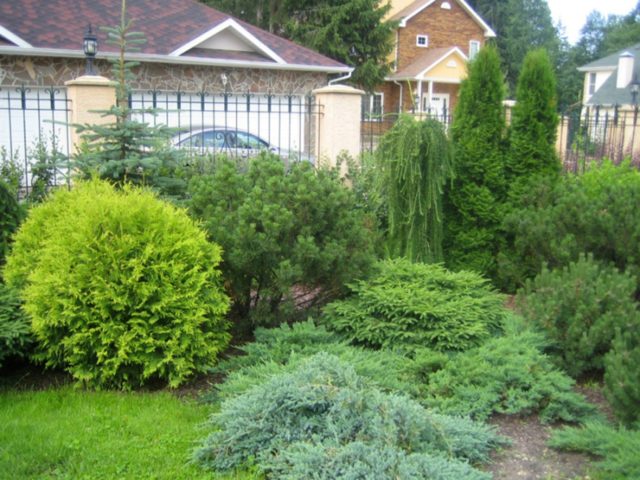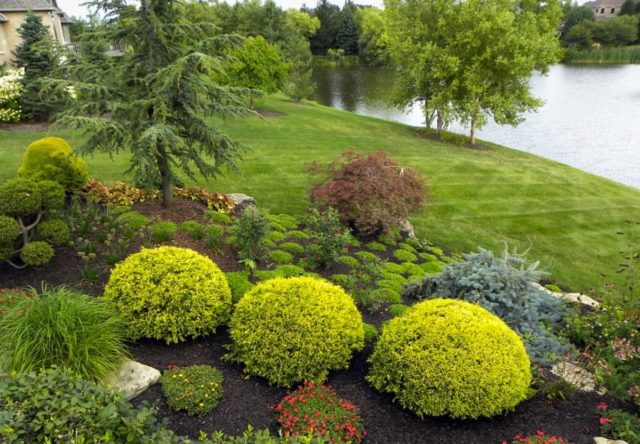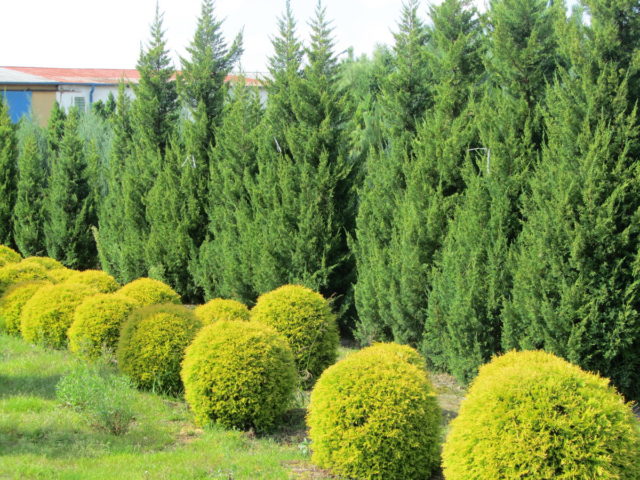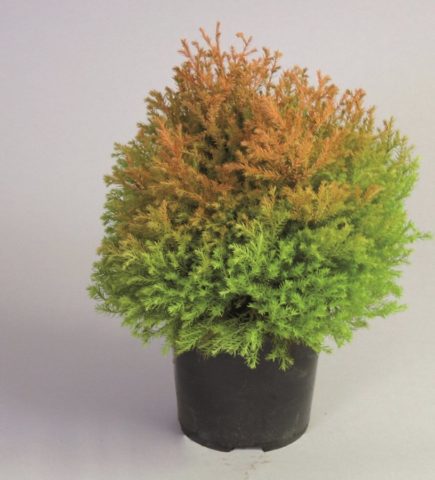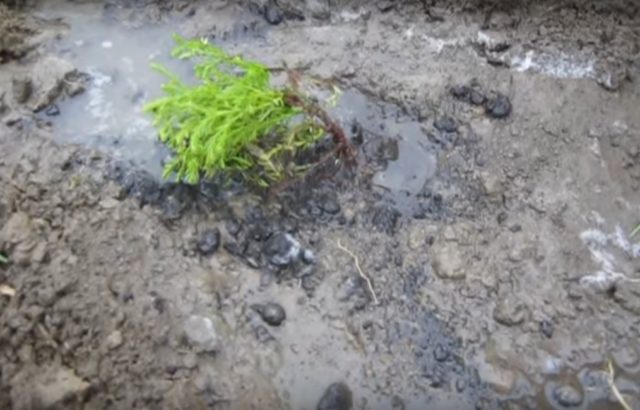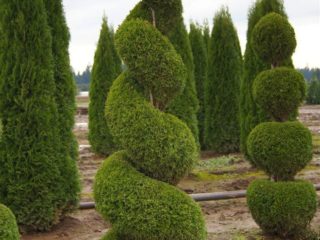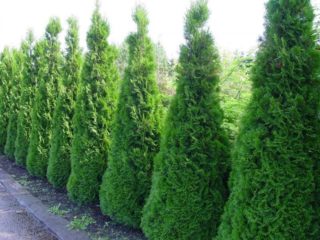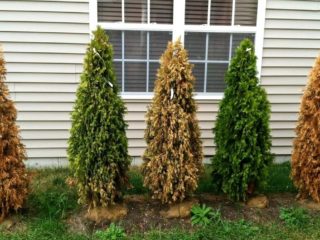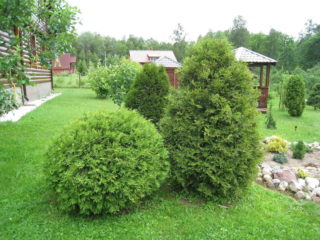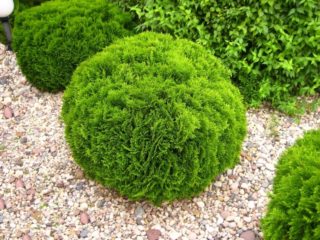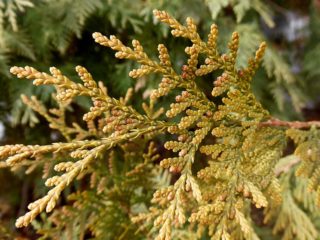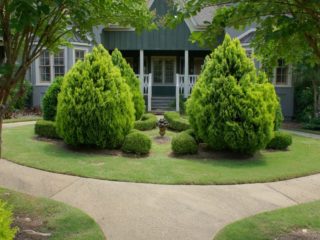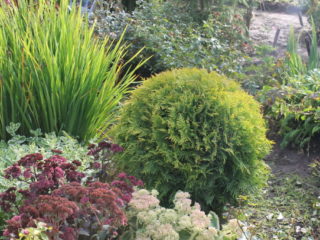Content
In landscape design techniques and decorative gardening options, thuja occupies a leading place among large-sized plants. Western thuja, a coniferous tree with a high frost resistance, is suitable for use in temperate climate zones. The wild species became the basis for work on creating new varieties. Thuja Reingold is an artificially bred form of German selection, which received from its Western ancestor high frost resistance, ease of care, and longevity.
Description of thuja Reingold
Western Thuja Reingold is a highly decorative representative of the species. Culture was created for the design of plots, gardens, and urban areas. The thuja grows in the form of a shrub; by the 10th year of the growing season, the height reaches 1.2 m, the growth on average is 6 cm in 12 months. The crown of Thuja Reingold is dense, round or spherical in shape, and lends itself well to molding. The tree reaches its final growth point at the age of 35-40 years. Depending on conditions, it can grow up to 2-3 m.
External description of thuja western Rheingold (pictured):
- Thuja is formed by numerous short branches of medium thickness. The length of the lower and upper branches is the same. The color of the bark is dark burgundy with a brown tint.
- At the tops of young shoots, needle-like needles are formed; next year, the form becomes scaly. This year's needles are light yellow with a pink tint; in mid-summer the color changes to bright orange; in the fall the crown turns brown. The arrangement of needles is dense, they are tightly pressed to the stems. The decorative effect of Thuja Reingold is given by the uneven color of the crown: the lower part is green, the top is orange.
- Thuja Reingold forms cones every year in small quantities; they are dark gray, up to 10 cm long, and consist of thin, densely spaced scales. The seeds are brown, small, equipped with light beige narrow wings.
- The root system is mixed, intertwined, the central roots go 50 cm deep.
The variety of western thuja Rheingold does not react to gusts of wind and resists drafts well. The vegetation is not affected by gas pollution and smoke in the surrounding urban environment. The peculiarity of the exotic coloring of the thuja Rheingold is fully revealed in an area with no shade.
Once every three years, the crown is renewed, the upper part of the shoots falls off, and in their place the thuja forms a replacement.
The use of western thuja Rheingold in landscape design
Western thuja variety Rheingold is one of the popular decorative forms used in the design of gardens and personal plots.Thanks to the color of the crown, the plant blends harmoniously in any combination with low-growing flowering plants, shrubs and large conifers. Insignificant annual growth is a priority when choosing thuja. The shrub maintains its given shape for a long time and does not require constant trimming. Photos of the use of western thuja Rheingold in ornamental gardening are presented below.
Thuja as part of a composition with flowering plants and exotic shrubs.
On the sides there are paths to the main entrance.
Thuja in a group planting with juniper and dwarf conifers.
Combines harmoniously in mixborders with plants of various colors and shapes.
As a hedge, as a lining for large trees.
Tapeworm in the center of a flower bed.
Features of reproduction
According to the description given by the originator, Thuja Reingold reproduces vegetatively and generatively. Regardless of the method, the survival rate of the shrub is good. Planting seeds takes longer than vegetative propagation.
Western Thuja Reingold seeds fully retain the characteristics of the parent bush. The material is collected at the end of October and sown directly into a container or mini-greenhouse. The container is left on the site and covered. The seeds will undergo natural stratification over the winter and will sprout in the spring. During the spring-summer season, the seedlings are watered; when the weather settles, the covering material is removed. The next year, in mid-summer, the seedlings are planted in separate containers. A year later in the spring, thuja Reingold is planted on the site. At least three years must pass from the moment the seeds are sown until they are placed in a permanent place.
Propagation by cuttings of western thuja Rheingold is more effective: from the preparation of material to planting it takes two years.Cuttings are cut in July from last year's shoots. Take the middle part, 25-30 cm long. Place it in fertile soil. Cover it up for the winter. The next season the plant is watered, by autumn it will be clear which cuttings have taken root. In spring they are planted in a permanent place.
Western thuja variety Rheingold also reproduces by layering. This method is less productive and is used less often; cuttings take root at 60%, and there is no guarantee that the young shoots will survive the winter even with good protection from frost. To obtain planting material, the lower branch of the thuja is bent to the ground and dug in, constantly watered; the soil at the site of the layering must not be allowed to dry out. The work is carried out in the spring, in a year it will be seen how many plots have been created, they are cut and immediately planted on the site.
Planting and caring for Western Thuja Rheingold
If the cultivation of western thuja Reingold involves the use of independently prepared material, the root system is inspected, damaged fragments are removed, placed in a manganese solution for 6 hours, then in a growth-stimulating drug for the same time, “Kornevin” is suitable. Seedlings obtained generatively are removed from the container along with the root ball, disinfected, and a growth stimulator is used. A seedling purchased from a nursery does not require antifungal treatment. It is better to take planting material with a closed root at the age of three years. The photo shows a Thuja Reingold seedling of the optimal size for planting.
Recommended timing
According to the description, thuja western Rheingold is a frost-resistant plant, capable of withstanding temperatures down to -38 0C and withstanding return frosts down to -7 0C, but these indicators refer to an adult plant.Young seedlings of thuja Reingold are less stable; if the bush does not have time to take root well before the onset of frost, there is a risk that the thuja will die. Therefore, autumn planting in regions with temperate climates is not recommended. Western thuja seedlings are placed in a permanent place only in the spring. It is necessary to wait until the soil warms up to +6 0C; for the Central zone this is the beginning or middle of May. In the South, thuja Reingold has time to take root after autumn planting if the work is carried out in early September. Spring planting time for regions with mild climates is early or mid-April.
Site selection and soil preparation
Thuja western Rheingold is valued for its decorativeness and crown density. In order for the needles to have a bright color and grow thickly, the shrub needs a sufficient amount of ultraviolet radiation. In the shade the color will be dull and the crown will be sparse. The site is chosen open, without shading.
Thuja prefers fertile, well-oxygenated, light, neutral or slightly acidic soil. The best option for Rheingold is loamy soil without groundwater close to the surface. If the area is marshy, thuja is planted on a hill on the south, east or west side.
Before planting thuja Reingold, the area is dug up, organic matter is added, and if necessary, the composition is neutralized with lime or dolomite flour. A nutrient substrate is first prepared from sand, peat, compost and turf soil in equal proportions. For 10 kg of mixture add 200 g of urea and 100 g of superphosphate.
Landing algorithm
The planting pit for thuja western Rheingold is prepared 24 hours in advance. The size of the recess depends on the volume and length of the root system. If the root is closed, the width does not exceed the size of the earthen ball, the depth is 70 cm.If the root system is open, the width of the hole is 15 cm larger, approximately 50*50 cm.
Description of the process of planting thuja western Rheingold:
- A 20 cm layer of drainage cushion is poured into the bottom of the recess, consisting of coarse gravel on the bottom and small crushed stone on top.
- The fertile mixture is divided into two parts, one part is poured onto the drainage.
- The seedling is placed in the center.
- Cover with the rest of the substrate and compact so that there are no voids.
- Fill to the top with the remaining soil.
- Water and mulch.
The neck should not be deepened or raised too much above the soil; the successful establishment of the thuja on the site depends on this point. The photo shows a Thuja Reingold seedling after planting.
Rules for growing and care
Thuja western Reingold is unpretentious in care. To achieve a decorative habit, it is recommended to follow simple rules regarding watering, sanitary cleaning of the crown and preparations for winter.
Watering schedule
Thuja Reingold is a heat-loving plant with average drought resistance. The watering schedule is based on seasonal precipitation. Required amount of moisture for young seedlings: 7 liters twice a week. An adult plant is watered 2 times a month (15-20 l). Watering is carried out in the morning or evening. When air humidity is low, Thuja Reingold requires sprinkling, which is best done early in the morning, the amount of water is not limited, the procedure can be carried out daily. To maintain moisture and prevent burns to the root system, the tree trunk circle is mulched.
Top dressing
Microelements added during planting are enough for the seedling to grow for 4 years. Then Thuja Reingold requires annual feeding.In spring, seedlings are fertilized with special products for the Cypress family; you can replace them with Kemira-station wagon. In July, a solution of organic matter is added to the root.
Trimming
Western thuja Rheingold grows slowly, the crown is dense, of a regular round shape, young shoots do not protrude beyond the visual border, so formative pruning of the thuja is not required. Cleaning is carried out in the spring before the sap flows; it is of a healing nature; dry fragments are removed, and weak, twisted shoots are cut out.
Preparing for winter
An adult thuja Reingold tolerates low temperatures without loss; frozen shoots are completely restored during the growing season. In winter, the shrub is watered abundantly and the root circle is mulched. For the winter, young thuja seedlings are covered with special material and covered with dry leaves.
Pests and diseases
Thuja western Rheingold is highly resistant to pests and diseases. At high humidity, late blight may develop. Fungal infections are treated with fungicides and watering is reduced. Among insects, thuja is affected by aphids; the pest is destroyed with Karbofos. Moth caterpillars are less common parasites on shrubs; they are collected by hand, and the crown is treated with Fumitox.
Conclusion
Thuja Reingold is a dwarf evergreen representative of the western thuja. A highly ornamental shrub with a bright golden crown, due to its drought resistance, winter hardiness and low maintenance requirements, is a leader in consumer demand. The plant is used in landscape design. Thuja harmoniously combines with tall trees, dwarf forms of conifers and flowering shrubs. The crop produces insignificant annual growth and does not require crown formation.
